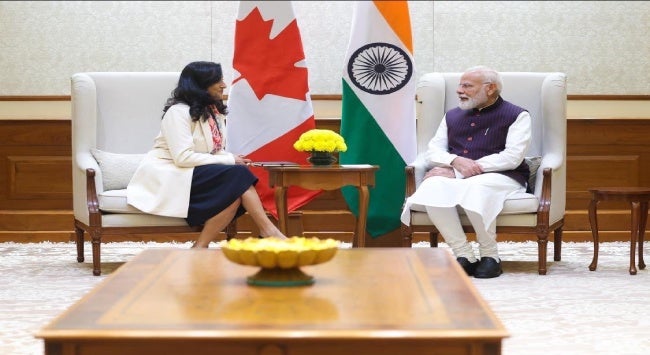Canada-India Bilateral Ties:
The Case for an Economic Security Framework
Karthik Nachiappan
15 October 2025Summary
The time is ripe for Canada and India to establish a viable and rational framework across areas like defence, energy, trade and technology to propel relations.
Canadian Foreign Minister Anita Anand’s visit to New Delhi and Mumbai from 12 to 14 October 2025 comes two years after the biggest crisis in Canada-India relations. The return of United States (US) President Donald Trump, Canadian Prime Minister Mark Carney’s rise and a transformed global landscape have all shaped this moment – one where both countries appear poised to refocus their relationship after a reset earlier this summer.
Anand’s visit is an opportunity to reboot ties, restore confidence and insulate it from the difficult diaspora politics that has long shadowed the relationship. Carney and Anand must anchor this reset on economic security, enabling both countries to support each other’s economic interests in ways that strengthen their sovereignty and resilience. This approach would represent a major departure from the past.
In Ottawa, India has generally been viewed as a bulwark against China, an attractive market, a source of immigration and a key node in the Indo-Pacific. However, these logics have largely run their course. India must instead be seen as a peer and strategic partner – one to engage with across critical domains such as emerging technologies, energy, climate change, agriculture and defence. The Trump administration’s return has heightened the importance of India as an economic partner for Canada’s allies across Europe and Asia, given India’s high growth rates, potential as a supply-chain hub and its growing prominence in areas like clean energy, digital technologies and infrastructure.
For Ottawa, refocusing ties around economic security means making India more than just a trade partner. It means building a strategic partnership that enhances resilience, reduces dependencies, manages supply-chain risks and deepens coordination on digital and clean energy technologies. The window to accomplish this ambitious task remains open but it is narrow.
Anand’s priorities in New Delhi will likely centre on trade and investment. Discussions could ostensibly revive negotiations for an Early Progress Trade Agreement, which was suspended in September 2023. Securing either an interim or comprehensive trade agreement will take time, especially as both sides balance parallel negotiations with the US and India with the European Union (EU). Yet it is important that the prospect of a trade deal does not overshadow or delay the work of connecting both economies in high-growth sectors such as the digital economy, artificial intelligence (AI), energy and critical minerals. Attention should shift beyond trade toward investment, standard-setting and technological exchange – areas where opportunities for Canadian firms are immense.
India is rapidly scaling capabilities across multiple sectors, including defence manufacturing, semiconductors, space, clean energy, critical minerals, digital technologies and infrastructure. These strides make New Delhi a viable, if still complex, long-term partner for Ottawa. Enhanced cooperation could take several forms. Both countries should sign a bilateral investment agreement with provisions protecting investments in sensitive sectors; establish a joint technology partnership, modelled on India’s frameworks with the US (Initiative on Critical and Emerging Technology/ TRUST Initiative) and the EU (EU-India Trade and Technology Council), to spur collaboration in semiconductors, space, AI, telecommunications and clean energy alongside a mechanism to harmonise standards on data flows, cybersecurity and digital identity, to facilitate secure and trusted digital trade, and finally establish an energy and critical minerals compact to connect Canadian resources with India’s rising demand.
Such an economic security partnership will not be without challenges. Canadian firms will face regulatory hurdles navigating India’s federal system, complicating large-scale projects. The absence of bilateral coordination on standards and rules, particularly in defence and electronics, where dual-use concerns arise, will require deliberate engagement. Both sides must rebuild trust on governance and transparency, addressing issues like export controls, non-tariff barriers and intellectual property protections to increase trade. Moreover, India’s emphasis on self-reliance and its selective industrial liberalisation may limit Canadian participation in sensitive sectors.
Both countries will also have to confront the politics and potential fallout from the legal processes surrounding the Nijjar killing, which may bring uncomfortable truths to light. That difficult reckoning will form part of the broader reset and reconciliation process, as diplomats work to build political, legal and economic frameworks to manage challenges and opportunities in the relationship.
Nevertheless, the potential payoffs from continued and sober engagement are mutual, strategic and far-reaching. For Ottawa and New Delhi, an economic security-focused partnership would lend stability and ballast to a relationship long prone to episodic political crises. It offers a long-term pathway for both countries to diversify, hedge against global uncertainties and work together to shape the economic and technological order in the Indo-Pacific.
. . . . .
Dr Karthik Nachiappan is a Research Fellow at the Institute of South Asian Studies (ISAS), an autonomous research institute at the National University of Singapore (NUS). He can be contacted at isaskn@nus.edu.sg. The author bears full responsibility for the facts cited and opinions expressed in this paper.
Pic Credit: X
-
 More From :
More From :
-
 Tags :
Tags :
-
 Download PDF
Download PDF



